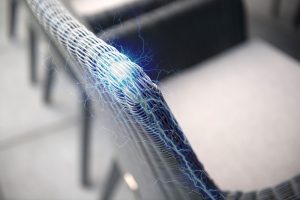Last updated on March 23rd, 2022
Except you live in the tropics, you’re more likely to experience static electricity, especially during those times of the year when the weather is cold and dry. It could be your clothes sticking to each other or you getting painful static shocks when you touch an object – metal, carpet, or a piece of furniture. In this article, we will look at how to remove static electricity from outdoor furniture. So, how do you go about this?You can rub the furniture with dryer sheets or fabric softener. You can also spray the furniture with an anti-static product or a mixture of water and vinegar. Using a humidifier might work if the furnishings are located in an enclosed area such as a pergola.
While static electricity doesn’t pose any serious threat or danger, it can be somewhat startling and even annoying, especially when unexpected. So, in this article, we will look at how to remove static electricity on various types of furniture and upholstery.
Table of Contents
What is static electricity?
Static electricity occurs when there’s a buildup of electric charge on the surface of a material. As this charge moves to the surface of another material, electricity is released, leading to a static shock or spark. Sometimes, the objects in contact might even cling to each other.
Every object (including humans) is made up of atoms, which comprise three charged particles – proton (positive charge), electron (negative charge), and neutron (neutral). However, these charges are often balanced within most objects, thus causing them to be neutral.

Static electricity happens whenever there’s an upset in the neutrality of an object, such that it has more positive or negative charges.
That is why it’s called a “buildup” of electrical charges. It’s not that there were no charges initially on the surface of the object. It’s just that these charges were balanced. But when the positive and negative charges become unequal (which can be triggered by friction or changes in the weather), it results in static.
These charges will continue to amass on the surface of the object until they can be discharged. And in most cases, this happens when they are connected to a circuit, which is usually another object.
Although static electricity doesn’t pose any serious risk or danger, it can be painful and annoying sometimes. The good news is that there are ways to combat it. We will soon look at these soon.
Why does my patio furniture shock me?
Your patio furniture and the material: If your patio furniture is shocking you, it might be coming from the material. Outdoor pieces made from plastic or rattan often create static electricity when they come in touch with your clothing. This often leads to an electrostatic shock. This is more common when the furniture or deck is not grounded.
Drop-in humidity and climate: Changes in humidity and climate are also responsible for static electricity. There’s always an increase in static when there’s a drop in humidity, and the air gets colder. This is more common when people try to heat up their homes in winter.
Friction: Shuffling around a piece of furniture can create friction which causes static to build as a result of unequal negative and positive charges between both surfaces. Sometimes, this can happen by just sitting and standing from a seat.
Touching the ground: As earlier indicated, static build on an object will try to escape via a circuit to a grounded source. Thus when you sit in a chair without making contact with the ground, static might be created between your clothes and the chair. The moment you touch the ground with your feet, you become grounded as the charges get discharged through you. This is when you get shocked.
How to get rid of static electricity on outdoor furniture?
As earlier indicated, static electricity doesn’t present any real threat, but the feeling can be painful and frustrating. Here are a few ways to prevent static electricity.
1. Use a Humidifier
One of the main causes of static is a drop in humidity. This is because static electricity is more active when the air is dry. You can run a humidifier to add moisture to the dry air to reduce humidity and buildup of static charges as one of the ways to prevent static electricity.
This method is most practical to reduce static electricity in a closed space such as a room in your home. If you’re going to use a humidifier outdoor to remove static electricity, then make sure it’s in a pergola or any other place that is enclosed.
If you don’t have a humidifier, you can boil water on a stove.
2. Use Dryer Sheets
Static electricity can build up on the surface of fabrics like your clothing, carpet, or upholstery. Since it’s not possible to throw your furniture into the dryer, you can wipe it down with a dryer sheet. They reduce static electricity by neutralizing static charges on the surface of the upholstery.
3. Use an anti-static product or create your own
You can purchase an anti-static spray, or static guard for furniture online or from a local grocery store. Make sure the anti static treatment is safe to use with kids and pets around, and follow the instructions.
If you decide to make your own spray, you will need to combine three parts water with one part fabric softener. The fabric softener should be one that is developed for preventing static cling. If you’re not able to get a fabric softener, you can use vinegar. Just combine an equal amount of vinegar and water in a spray bottle, and spray lightly on the furniture. Vinegar is known to get rid of static charges.
4. Use Rubber Caps
You can also try placing rubber caps at the feet of the furniture or a rubber mat to prevent electricity flow. There are many anti-static mats designed to remove static electricity.
However, due to the nature of rubber as an insulating material, using it can create the exact opposite effect. So instead of reducing static buildup, it can actually cause more of it. Of course, you can give it a shot, but if it doesn’t help, then you can remove the rubber feet or mat and ground the furniture instead.
5. Ground the furniture
Grounding provides a pathway for static electricity to be discharged to the ground. Whenever static buildup in an area, it will try to locate the fastest path to the ground with the least resistance. That is why you should not be outside whenever there’s a thunderstorm, as your body can also serve as a circuit.

Lightning usually hits the tallest objects around to get to the ground faster. These include trees, metals, and, sometimes, humans.
You can apply the same principle when you experience static buildup – just touch a metal that is connected to the ground, or you can touch the ground itself. This also applies to your garden furniture. You can ground them to avoid static shock.
Other Tips
● Keep your patio floor clean: Keeping your patio floor clean can also help in reducing static buildup by cutting down the amount of dust in the area.
● Wear natural fabrics: During winter, try to wear more natural fabrics such as cotton. Synthetic materials like nylon and polyester tend to hold on more to static charges, thus creating static shock when you touch an object.
● Keep your skin moisturized: Just like dry air, dry skin can also conduct static. Keeping your skin moisturized with lotion will help prevent this.
How to Get Rid of Static Electricity in Your Microfiber Furniture?
Microfiber is a great conductor of electricity, so furniture made with the fabric is always at risk of a static buildup. To prevent static clings and shocks when you sit on the furniture, follow the tips below:
● Rub the furniture with a dryer sheet as described in previous sections. In addition to reducing static cling, this will leave your couch or sofa smelling nice. You only need to do it a couple of times and when you feel the problem is returning. If you don’t have dryer sheets, you can mix water and fabric softener to create your own static reducing spray. The process is the same as described earlier.
● You can also apply a static guard to take care of the problem. But make sure you check the instructions on how to use it. To be sure, you can test a small amount on the back or beneath the sofa. The good thing about this product is that you only need to apply it once, and the effect can last for a long time. Besides reducing static, it can also help to make your couch stain-proof.
● If you have the furniture in a storage room inside your home or an enclosed space outside, such as a pergola, you can run a humidifier to add moisture to the air.
● Lastly, you can locate the section of the furniture where you’re experiencing static and run a wire hanger along with the place. This should be done with care to avoid scraping or puncturing the material.
How to get rid of static electricity on plastic outdoor furniture?
Plastic is an insulating material, so it normally holds static charges. This is why static electricity easily buildup on plastic outdoor furniture. This problem is most prevalent during the winter seasons or in dry climate areas.
To get rid of this, you can use an anti-static spray or any of the other methods we’ve described earlier.
Other materials that seem to work well when added to get plastic matrix are graphite and wax. The major challenge with this solution is the color of the material.
For instance, carbon (graphite) is black, which may not always suit your application. Also, carbon can affect the mechanical properties of plastic furniture. Thus, even though it might be effective, we do not recommend this method.
Alternatively, if you do not want to use any anti static chemical, you can hose down the plastic furniture. But you have to do this consistently for it to work.
How to get rid of static electricity on rattan furniture outdoors?
Wicker is not a material but a weaving process, so rattan furniture can be made from any material.
Thus, to get rid of static on rattan, you have to find out what material it’s made from. If it’s plastic, you can use a good anti-static spray. Don’t hose down rattan as much moisture can encourage the growth of mildew. Likewise, wipe it down whenever it gets wet or is rained upon.
If the legs of the chair are fitted with rubber caps, this will insulate it and prevent the flow of static charges to the ground. So, you can remove the caps to ensure the rattan furniture is well-grounded.
What are the best anti-static spray for garden furniture?
The best anti-static sprays for garden furniture are those specifically formulated for outdoor use. This is important because normal sprays can easily get worn down by the weather.
Whatever product you choose, make sure it can resist static cling and can be used on chairs with shocks.
Our top two recommendations for the best anti-static spray are StaticEX and Static Guard Aerosol. Static Guard is probably the more popular option for outdoor furniture.
Both sprays can stop any form of static charge buildup and counter static electricity. These include your garden furniture, clothing, and car. They have a light scent and are not harmful to kids and pets. You only need to spray one time to see results.
Before using any of the products, make sure you read the instructions on the bottle.
Best homemade anti-static spray for furniture
The best homemade anti-static furniture spray is one made with water and fabric softener. This is a great alternative to the more expensive dryer sheets available in stores. In this case, you can mix one part fabric softener with three parts distilled water in a spray bottle. Shake well and apply to your upholstery.
Another thing you can use in the place of a fabric softener is vinegar. Here, you can mix an equal amount of water and vinegar in a bottle and spray lightly on the furniture to reduce static.
Conclusion
We will draw the curtains here. By now, you should have gotten some good knowledge on how to get rid of static electricity on outdoor furniture.
So, the next time you get a little shock or notice static on your patio furniture. You can try out these methods on how to remove static from furniture and make your winter months more enjoyable.
Let us know if you have any more questions, and we will be glad to help. Until then, happy grounding!
Frequently Asked Questions.
Why Am I generating so much static electricity?
The build-up of static charges is increased when the air dry. Therefore, static effects are usually common during dry air conditions. Outside air can be very dry during cold and dry weather, while indoors, air conditioning and central heating system can give dry conditions and promote static charges.
Can you use static guard on furniture?
Yes. But before you use it ensure you clean the furniture with a dryer sheet to reduce static clings and make the furniture clean and smell fresh. Test a small amount of static guard on the underneath or back of the sofa first to see how it reacts before applying on the whole furniture.
Does Febreze help with static?
No. The products used in making Febreze are not formulated to work against static charges. Alternatively, you can use Downy or bounce to help against static on furniture covers and clothes.
What Can I touch to get rid of static?
Materials like glass, hair, and glass give electrons very easily. When they undergo friction, these electrons build up, causing static electricity. The easiest recommended way to remove static from the body is to touch any grounded material such as screws on switch panels.
What causes excessive static electricity?
Static electricity increases when the weather is very cold and dry. Therefore, static shocks occur mostly during winter when the air is very dry. This is the reason, the clothes look disheveled, the hair fizzy and people experience shock when they reach for doorknobs.

